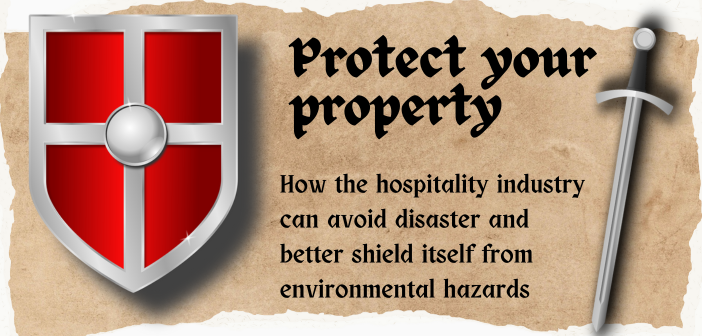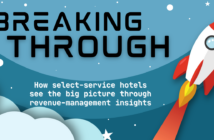How the hospitality industry can avoid disaster and better shield itself from environmental hazards
by STEFAN BURKEY and PLACITO MICELI
The fatberg excavated from the Tampa, FL, sewage system in 2020 was 108 cubic yards of grease, baby wipes, and various other flushed, non-biodegradeable solids, carrying the distinctive odor of rotting meat combined with an unclean toilet.
It wasn’t a unique phenomena to Florida, and the problem can’t be laid solely at restaurants’ doors for their grease-disposal failures. But, the cost of repairing the blockages and flooding that fatbergs cause has led Florida (among other jurisdictions) to tighten regulations around grease waste and graywater returns.
It’s yet another of the fast-growing number of environmental hazards of which the hospitality industry needs to be aware. Risks to employees, guests, and the public at large are mounting, which result in escalating damage claims.
These exposures also make risk mitigation a priority for the industry as securing adequate insurance against them can be a complex challenge.
THE EXPANDING SCOPE OF ENVIRONMENTAL RISKS
It’s a fact. Guests don’t treat a hotel as well as they treat their homes. As an extreme example, claims have been made for environmental damage caused by meth labs in extended-stay properties. One Bahamas hotel filed a whopping $20 million claim to remediate extensive mold caused by guests who left the air conditioning blasting while doors and windows were left open.
And there’s more:
- Cleaning solvents pose third-party bodily injury exposures.
- Over-treated swimming pools can cause chemical burns.
- Fertilizers and other pollutants used on golf courses pose a hazard through runoff-groundwater infiltration.
- Improperly managed water systems can harbor bacteria that may cause legionella and other diseases.
- Improperly stored and discharged food waste products from restaurants can contribute to fatbergs, among other issues.
- Contaminants can migrate from neighboring properties, like fumes from a gas station.
THE INS AND OUTS OF INSURANCE
Policy design for environmental risks used to be flexible – and overly broad. But, rising liabilities and claims have led insurers to be more stringent in what they will and won’t underwrite, often favoring “best-in-class” properties. Also, retentions are higher, particularly for coastal properties where environmental risks such as mold are common.
There can be substantial variations in how policies are written and what specific risks are covered. Policies designed for an industrial site, for example, may be wrongly placed with a hotel. Pre-existing conditions may be unaddressed. There may be coverage flaws – say, mold is excluded.
It may be tempting to buy a policy based on price, but it’s ultimately a lot more costly because of the nuances. Per-room deductibles for mold remediation can hit $50,000. There may be sub-limits of coverage for mold or legionella. Legal defense costs may be capped. Some insurers cover third-party bodily injury but not property damage or clean-up – others, the reverse.
It’s important to be aware of where general liability ends and environmental insurance begins. General liability policies disallow pollutants defined as any “solid, liquid, gaseous, or thermal irritant or contaminant, including smoke, vapor, soot, fumes, acids, alkalis, chemicals, and waste.” These exposures are covered under environmental insurance, providing protection for bodily injury, property damage, and/or cleanup costs.
HOW TO MANAGE THE RISKS
Best-in-class properties make environmental risk mitigation a priority. Important measures include:
1. Having a plan for managing the biggest risks.
A comprehensive chemical storage plan, for example, sets out best practices for cleaning, maintenance, and disposal of chemicals such as cleaning solvents and pool chemicals. Water intrusion plans will head off mold problems. Train staff appropriately, document everything, and share the plans with carriers.
2. Making maintenance a priority.
One hotel’s legionella plan called for regularly flushing toilets and running showers and faucets in unoccupied rooms to offset the risk of legionella growing in the pipes.
3. Making environmental mitigation a priority during renovations.
The facelifts most hotels undergo regularly are an opportunity to uncover potential problems.
4. Making controls count.
Particularly with coastal properties, the risk of mold-related losses is high. Regularly scheduled air duct cleanings will offset risk of mold contamination. It’s also worth investing in sensors to automatically shut off air conditioning when doors are left open to reduce the risk of moisture condensing to form mold.
5. Coordinating with your insurer or insurance broker ahead of time to determine qualified vendors.
By working with them first, you can expedite repairs, possibly negotiate the rate of service, and ensure proper risk protocols are in place before an incident occurs. Don’t risk a not-necessarily-qualified or non-approved “expert” being brought in to do the work. Call your insurer immediately for emergency situations regarding urgent action. In 99% of situations, the carrier should be involved immediately or the claim is unlikely to be covered.
Many states are adopting greater protections and larger fines for environmental issues – hazardous or not. Taking a pre-emptive stand regarding them affords greater protection against claims and makes for stronger businesses.

Stefan Burkey

Placito Miceli
Stefan Burkey is the hospitality practice leader for HUB International Florida. In this role, he oversees insurance placement solutions for owners, developers, and operators from limited-service hotels to full-scale resorts. Stefan and his team clearly understand the financial needs and exposures associated with the hospitality industry, and their singular focus has generated profound market knowledge and significant buying power for HUB clients throughout Florida and the U.S.




